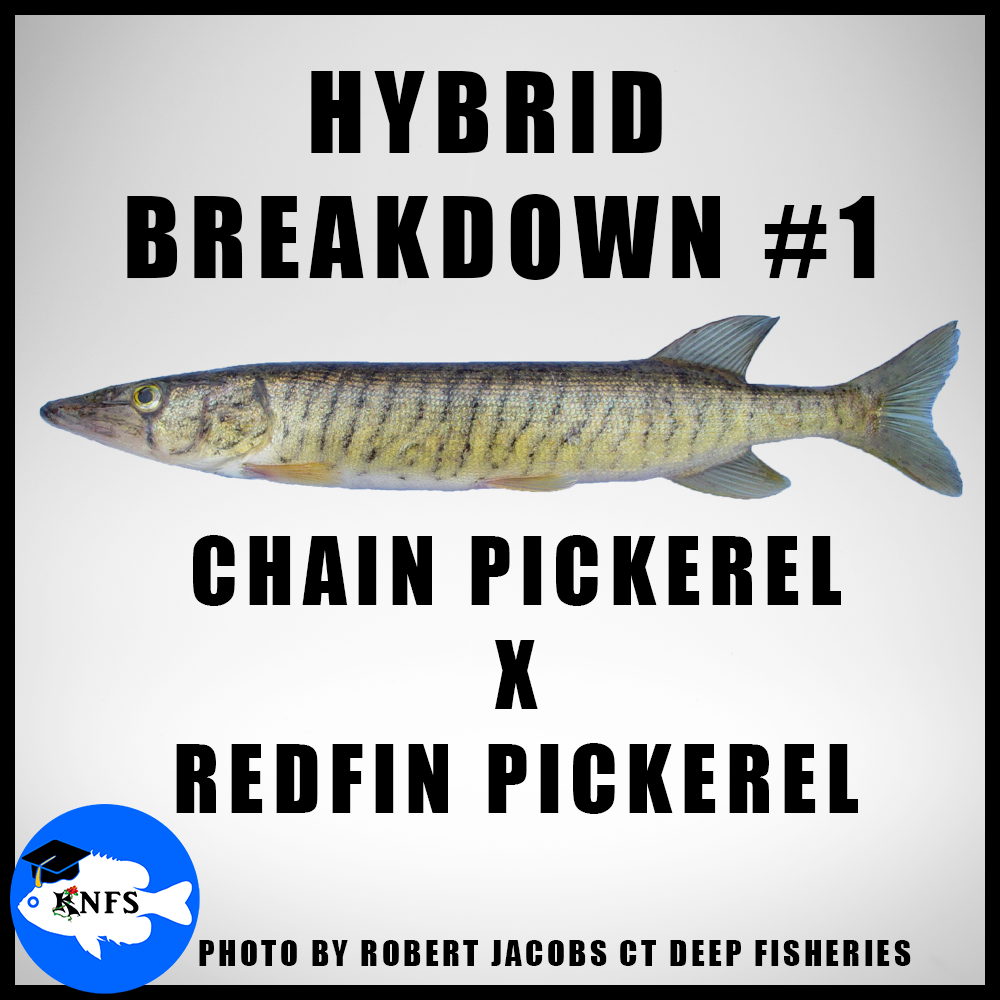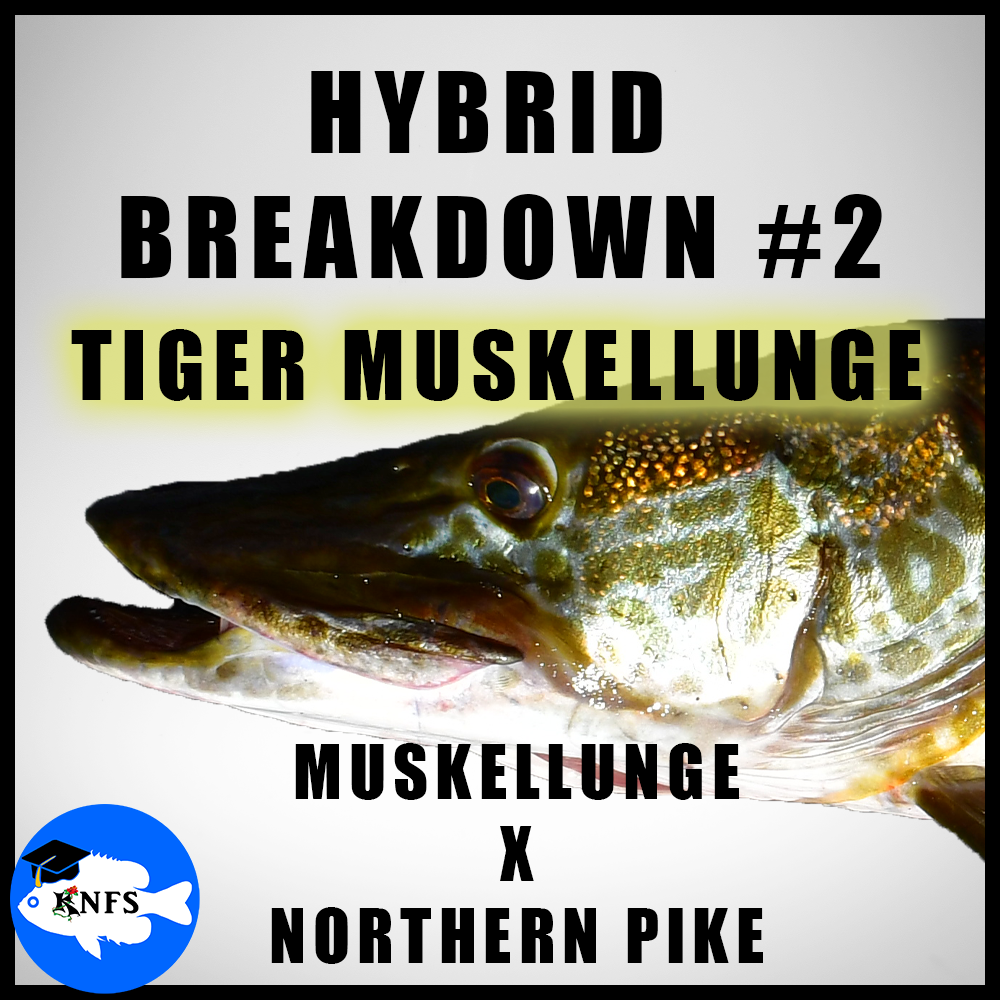By Koaw 2023 -
Hybridization within the genus Esox has been fairly well documented for the last 100 years or so where at least 6 intrageneric (within genus) hybrids have been known to occur naturally in North America. Artificial crossings, or crossings where humans have interfered to assist the process, have produced even more variations of hybrids. [1-6]
The naturally produced known hybrids are (1) E. niger (chain pickerel) x E. a. americanus (redfin pickerel), (2) E. niger x E. a. vermiculatus (grass pickerel), (3) E. masquinongy (muskellunge) x E. lucius (northern pike), (4) E. lucius x E. niger, (5) E. lucius x E. a. americanus, and (6) E. lucius x E. a. vermiculatus. (See adjacent photo for appearances.)
The subspecies of the American pickerel (Esox americanus) are the grass pickerel (E. a. vermiculatus) and the redfin pickerel (E. a. americanus). These subspecies are considered as unique fishes in the above ‘natural hybrid’ considerations while their crossing (E. a. americanus x E. a. vermiculatus), though also a viable and naturally found crossing in a very limited range, is an intraspecific (within species) crossing and not considered as a ‘natural hybrid’ for these considerations; there are many intergrades in the southeastern United States that have mixed genetics between both subspecies.
Click to enlarge.
The tiger muskellunge, a hybrid produced by the crossing of the muskellunge (E. masquinongy) and the northern pike (E. lucius) is the most encountered hybrid within Esox.
The chain pickerel (Esox niger) x redfin pickerel (Esox americanus americanus) hybrid may be considered the second most likely hybrid to encounter behind the tiger muskellunge hybrid (E. masquinongy x E. lucius), perhaps even occurring naturally with more frequency. Both of these fishes have overlapping ranges, high survivability of hybrid offspring, and fewer physical/psychological mating barriers than what exists between the two larger species, the muskellunge and northern pike. Muskellunge tend to spawn later than any other member of Esox as well as in different locations than the redfin pickerel. Most sexual mature muskellunge are large enough to consider most sexual mature redfin pickerel as prey rather than a mating option. Northern pike seem to have more gamete incompatibilities with the pickerels, especially when a female northern pike is involved. [2]
IDENTIFYING HYBRIDS: Identifying hybrids is often very tricky. This author spent numerous hours analyzing the various intrageneric hybrids within the genus Lepomis for the common sunfishes guide and again for this Esox guide. It’s safe to say that hybrids offer serious challenges for identification—it’s not easy. There are certain steps that can be taken to better understand a possible hybrid. See this tiger muskellunge hybrid breakdown and the redfin pickerel x chain pickerel hybrid breakdown to further understand the identification process.
The only way an observer can truly begin to properly identify a hybrid is after that observer has mastered the identification of pure species in the genus. Once this familiarity is attained, certain peculiarities of a hybrid will stand out to an observer. The following chart with meristics will help a person decide on a hybrid ID along with the idiosyncrasies of the hybrid patterning vs. parent species.
Hybrids are strange because they express the combined shuffling of DNA from two unique species. As genetics are being swapped between two different species, there’s more tendency for odd features to arise, not just in coloration and patterning but also within the meristics (countable features) and morphometrics (measurable features). Although most features will be intermediate between the parent species, there will be some features that resemble more closely or almost entirely towards one parent species. At various stages of development some hybrids may resemble almost entirely like one parent species, such as is very true with many chain pickerel x northern pike hybrids where these specimens are indistinguishable from northern pike as juveniles and, even as adults, may appear very similar to northern pike.
A genetic test is truly the best way to ensure an identification is correct on a hybrid. However, genetic tests are primarily only used by researchers and fisheries managers. In the hybrid breakdowns mentioned above and linked below, I walk us through step-by-step how to go about identifying hybrids.
REFERERNCES:
[1] E. Crossman and K. Buss, "Hybridization in the Family Esocidae," J. Fish. Res. Bd., vol. 22, no. 5, 1965.
[2] K. Buss and J. Miller, "Interspecific Hybridization of Esocids Interspecific Hybridization of Esocids F1 Hybrids," U.S. Department of the Interior, Bureau of Sport Fisheries and Wildlife, 1967.
[3] J. D. Black and L. O. Williamson, "Artificial hybrids between muskellunge and northern pike.," Trans. of the Wisc. Aca. of Sci., vol. 38, pp. 299-314, 1946.
[4] S. Eddy, "Hybridization between Northern Pike (Esox lucius) and Muskellunge (Esox masquinongy)," Jour. of the Minn. Acad. of Sci., vol. 12, no. 1, pp. 38-43, 1944.
[5] D. V. McCarraher, "Pike hybrids (Esox lucius x E. vermiculatus) in a Sandhill Lake, Nebraska," Transactions of the American Fisheries Society, 1960.
[6] E. C. Raney, "Natural hybrids between two species of pickerel (Esox) in Stearns Pond, Massachusetts. Supp't to Fish. Rept. for some central, eastern and western Mass. lakes, ponds and reservoirs, 1951-1952," 1955.
[7] J. M. Casselman, E. J. Crossman, P. E. Ihssen, J. D. Reist and H. E. Booke, "Identification of Muskellunge, Northern Pike, and their Hybrids," Am. Fish. Soc. Spec. Publ., vol. 15, pp. 14-46, 1986.
[8] Koaw, "Select Morphometrics and Meristics of Esocids," Koaw Nature - KNFS, 2023.
[9] E. J. Crossman, "A Taxonomic Study of Esox americanus and Its Subspecies in Eastern North America," Copeia, vol. 1, pp. 1-20, 1966.
[10] C. L. Hubbs and K. F. Lagler, "Fishes of the Great Lakes Region, Rev. Ed.," vol. Bull. 26, 1958.
[11] C. L. Hubbs, K. F. Lagler and G. R. Smith, Fishes of the Great Lakes Region: Revised Edition, University of Michigan Press, 2004.


